Initial creation: 5-11-2024 | Last updated: 5-11-2024 Head back to the main page
This article is still being written, there may be unrevised segments or segments that haven't even been written yet. Don't get mad at me.
Hyperoceania
Hyperoceania
Hot superaquaria

Photo of Hyperoceania taken in 79 PE (2096 AD).
| Other names | The world, the globe, Earth, Terra, Tellus, Gaia, Aquaria, Poseidon |
|---|
Physical Characteristics
| Diameter | 6371 km |
|---|---|
| Circumference | 40075 km |
| Surface Area | 510072000 sq km |
| Surface Temperature | min: -12°C mean: 45°C max: 89°C |
| Average Orbital Speed | 1022 km/s |
Atmosphere
| Atmospheric pressure | 98.75 kPa (at sea level) |
|---|---|
| Composition by volume | 98.75% nitrogen 1.51% water vapor (varies) 0.94% argon 0.153% carbon dioxide 0.012% carbon monoxide 0.002% neon 0.001% helium >0.001% methane, krypton, and more |
Hyperoceania, formerly Earth, is a hot ocean world home to the human race. It is the third planet in the solar system, and is one of the only life-bearing planets in the Milky Way galaxy. Almost all of Hyperoceania's surface is a continuous tropical ocean, covering about 90% of the planet's surface. The remaining 10% is land, consisting of rocky islands (formerly mountain ranges), deserts, hills, and dry basins. Former human settlements are scattered throughout the landscape and seabed, however these are all abandoned due to the fact they are either far too hot to inhabit or are underwater.
Inhabitance
Regular surface inhabitance and residence on the planet is impossible due to the absence of oxygen, which would result in immediate inert gas asphyxiation. Due to this, all oxygen-breathing life is kept inside pressurised, controlled spaces where oxygen is produced and regulated to imitate atmospheric conditions prior to the First Industrial Revolution for the continuous healthy respiration of human beings inhabiting said space.
Human settlements typically actively monitor meteorological conditions in their surrounding area to watch out for hurricanes. Most are built to withstand CAT3 hurricanes, however some are reinforced and streamlined to withstand CAT5 hurricanes. Due to the global increase in temperature along with greater ocean surface area, hurricanes have significantly grown in wind speed, strength, and frequency since 0 PE (2015 AD). Settlements frequently communicate and relay weather information to eachother, even if they are political enemies.
Human settlements get their resources by salvaging old materials from abandoned cities on the mainland or underwater. Various former major cities have already been completely removed due to continuous salvaging, resulting in the complete disappearance of San Francisco, Chicago, Boston, Houston, Miami, Osaka, Sapporo, Amsterdam, Bordeaux, Bremen, and various other cities.
History
Pre-Greenhouse (1760 & prior)

A water powered ore mill in the late 19th century.
Prior to the First Industrial Revolution, humans' only source of mass greenhouse gas emission were their respiration. Humanity was largely agrarian prior to then, so there were no machines executing major manufacturing processes. Almost all work was done via means of manual labour, up until the utilisation of water wheels. Water wheels used the forces of flowing water to spin, driving a machine or contraption. They were first utilised by the ancient Greeks and Chinese around 1200-900 BC. Water wheels were used to construct water mills, one of the most impressive water mills being the Roman Barbegal Mill, which used 16 wheels to grind up to 28 tons of grain daily. This marks the one of the earliest methods humanity began to mechanise and automate their production and operations, and this would only escalate from here.
Humanity began to pollute with the discovery of metallurgy around 6000-5000 BC, which required high temperatures. This was accomplished by the use of furnaces, which required immense amounts of combustible fuel to burn, so that the metal material gets hot to the point it softens enough to be molded/formed into a desired shape. This released carbon dioxide — a greenhouse gas — and is one of the first instances of humanity beginning to mass-pollute the atmosphere. During the Bronze age metallurgy began to become rapid and utilised en-masse among the human race to manufacture tools, equipment, decorations, and weaponry.
Iugis-Greenhouse (1760-1987)